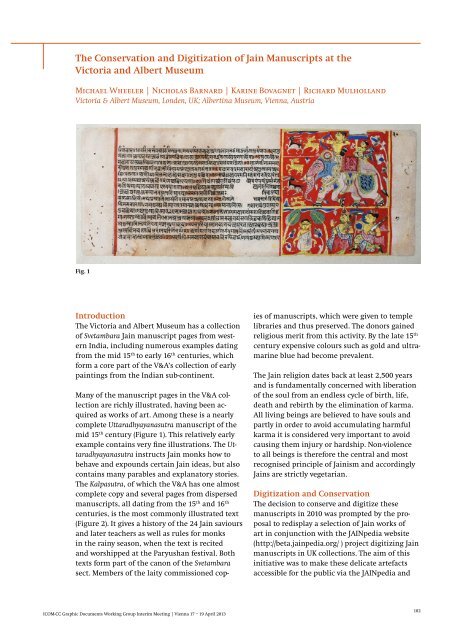Paper Conservation: Decisions & Compromises
Paper Conservation: Decisions & Compromises
Paper Conservation: Decisions & Compromises
Create successful ePaper yourself
Turn your PDF publications into a flip-book with our unique Google optimized e-Paper software.
The <strong>Conservation</strong> and Digitization of Jain Manuscripts at the<br />
Victoria and Albert Museum<br />
Michael Wheeler | Nicholas Barnard | Karine Bovagnet | Richard Mulholland<br />
Victoria & Albert Museum, Londen, UK; Albertina Museum, Vienna, Austria<br />
Fig. 1<br />
Introduction<br />
The Victoria and Albert Museum has a collection<br />
of Svetambara Jain manuscript pages from western<br />
India, including numerous examples dating<br />
from the mid 15 th to early 16 th centuries, which<br />
form a core part of the V&A’s collection of early<br />
paintings from the Indian sub-continent.<br />
Many of the manuscript pages in the V&A collection<br />
are richly illustrated, having been acquired<br />
as works of art. Among these is a nearly<br />
complete Uttaradhyayanasutra manuscript of the<br />
mid 15 th century (Figure 1). This relatively early<br />
example contains very fine illustrations. The Uttaradhyayanasutra<br />
instructs Jain monks how to<br />
behave and expounds certain Jain ideas, but also<br />
contains many parables and explanatory stories.<br />
The Kalpasutra, of which the V&A has one almost<br />
complete copy and several pages from dispersed<br />
manuscripts, all dating from the 15 th and 16 th<br />
centuries, is the most commonly illustrated text<br />
(Figure 2). It gives a history of the 24 Jain saviours<br />
and later teachers as well as rules for monks<br />
in the rainy season, when the text is recited<br />
and worshipped at the Paryushan festival. Both<br />
texts form part of the canon of the Svetambara<br />
sect. Members of the laity commissioned copies<br />
of manuscripts, which were given to temple<br />
libraries and thus preserved. The donors gained<br />
religious merit from this activity. By the late 15 th<br />
century expensive colours such as gold and ultramarine<br />
blue had become prevalent.<br />
The Jain religion dates back at least 2,500 years<br />
and is fundamentally concerned with liberation<br />
of the soul from an endless cycle of birth, life,<br />
death and rebirth by the elimination of karma.<br />
All living beings are believed to have souls and<br />
partly in order to avoid accumulating harmful<br />
karma it is considered very important to avoid<br />
causing them injury or hardship. Non-violence<br />
to all beings is therefore the central and most<br />
recognised principle of Jainism and accordingly<br />
Jains are strictly vegetarian.<br />
Digitization and <strong>Conservation</strong><br />
The decision to conserve and digitize these<br />
manuscripts in 2010 was prompted by the proposal<br />
to redisplay a selection of Jain works of<br />
art in conjunction with the JAINpedia website<br />
(http://beta.jainpedia.org/ ) project digitizing Jain<br />
manuscripts in UK collections. The aim of this<br />
initiative was to make these delicate artefacts<br />
accessible for the public via the JAINpedia and<br />
ICOM-CC Graphic Documents Working Group Interim Meeting | Vienna 17 – 19 April 2013<br />
102
















